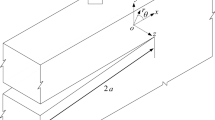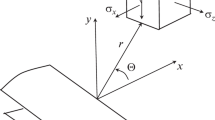Abstract
Three-dimensional finite element analyses were performed on plates with a through-the-thickness crack. Global-local finite element technique with sub-modeling was used to achieve the refinement required to obtain an accurate stress field. The existence of a weaker singularity was verified, and a model was proposed to explain the behavior of stresses in the boundary layer. This model is able to account for the competing interaction between the inverse square root singular term and the vertex singular term. The energy release rate was calculated using the modified crack closure method and energy balance. A simple technique without 3-D calculation was suggested for evaluating an approximate 3-D stress intensity factor at the mid-plane. The effect of plate thickness on the size of the three-dimensional region was studied, and the validity of two-dimensional linear elastic fracture mechanics was discussed.
Similar content being viewed by others
References
ABAQUS, (1996). Version 5.6, Hibbitt, Karlsson and Sorensen, Inc., Providence, R.I.
American Society of Mechanical Engineering (1988) Analytical, Numerical and Experimental Aspects of Three Dimensional Fracture Processes, Edited by Rosakis, A.J., Ravi-Chandar, K. and Rajapakse, Y. AMD, Vol. 91.
Atluri, S.N., Kathiresan, K. and Kobayashi, A.S. (1975). Three-dimensional linear fracture mechanics analysis by a displacement-hybrid finite-element model. Paper No. L-7/3, Transactions 3rd Conference on Structural Mechanics in Reactor Technology, London.
Ayres, D.J. (1970). A numerical procedure for calculating stress and deformation near a slit in a three-dimensional elastic-plastic solid. Engineering Fracture Mechanics 2, 87–106.
Bažant, Z.P. and Estenssoro, L.F. (1979). Surface singularity and crack propagation. International Journal of Solids and Structures 15, 405–426.
Benthem, J.P. and Koiter, W.T. (discussion), Folias, E.S. (closure) (1976). On the three-dimensional theory of cracked plates. Journal of Applied Mechanics 43, 374–375.
Benthem, J.P. (1977) State of stress at the vertex of a quarter-infinite crack in a half-space. International Journal of Solids and Structures 13, 479–492.
Benthem, J.P. (1980). The quarter-infinite crack in a half space; alternative and additional solutions. International Journal of Solids and Structures 16, 119–130.
Blom, A.F. and Andersson, B. (1990). On the semi-elliptical surface crack problem: Detailed numerical sulutions for complete elastic stress fields. Surface-Crack Growth: Models, Experiments and Structures, ASTM STP 1060 (Edited by Reuter, W.G. et al.), Philadelphia, American Society for Testing and Materials, 77–98.
Burton, W.S., Sinclair, G.B., Solecki, J.S. and Swedlow, J.L. (1984). On the implications for LEFM of the threedimensional aspects in some crack/surface intersection problems. International Journal of Fracture 25, 3–32.
Cruse, T.A. (1971). Three-dimensional elastic stress analysis of a fracture specimen with an edge crack. International Journal of Fracture Mechanics 7, 1–15.
Folias, E.S. (1975). On the three-dimensional theory of cracked plates. Journal of Applied Mechanics 42, 663–674.
Gregory, R.D. (1992). The general form of the three-dimensional elastic field inside an isotropic plate with free faces. Journal of Elasticity 28, 1–28.
Hartranft, R.J. and Sih, G.C. (1969). The use of eigenfunction expansions in the general solution of threedimensional crack problems. Journal of Mathematics and Mechanics 19, 123–138.
Hartranft, R.J. and Sih, G.C. (1970). An approximate three-dimensional theory of plates with application to crack problems. International Journal of Engineering Science 8, 711–729.
Kassir, M.K. and Sih, G.C. (1966). Three-dimensional stress distribution around an elliptical crack under arbitrary loadings. Transactions of ASME, Journal of Applied Mechanics 33, 601–611.
Kawai, T., Fujitani, Y. and Kumagai, K. (1977). Analysis of singularity at the root of the surface crack problem. Proceedings of the International Conference on Fracture Mechanics and Technology, Hong Kong, pp. 1157–1163.
Leung, A.Y.T. and Su, R.K.L. (1996). Analytical solution for mode I crack orthogonal to free surface. International Journal of Fracture 76, 79–95.
Moyer, E.T. Jr. and Liebowitz, H. (1984). Comparative study on three-dimensional crack tip modeling methodology. Application of Fracture Mechanics to Materials and Structures, Noordhoff, The Netherlands, pp. 595–606.
Nakamura, T. and Parks, D.M. (1988). Three-dimensional stress field near the crack front of a thin elastic plate. Journal of Applied Mechanics 55, 805–813.
Raju, I.S. and Newman, J.C. Jr. (1977). Three-dimensional finite-element analysis of finite-thickness fracture specimens. NASA TN D-8414.
Rosakis, A. and Ravi-Chandar, K. (1986). On crack-tip stress state: an experimental evaluation of threedimensional effects. International Journal of Solids and Structures 22, 121–134.
Rybicki, E.F. and Kanninen, M.F. (1977). A finite element calculation of stress intensity factors by a modified crack closure integral. Engineering Fracture Mechanics 9, 931–938.
Shivakumar, K.N., Tan, P.W. and Newman, J.C. Jr. (1988). A virtual crack-closure technique for calculating stress intensity factors for cracked three dimensional bodies. International Journal of Fracture 36, R43–R50.
Shivakumar, K.N. and Raju, I.S. (1990). Treatment of singularities in cracked bodies. International Journal of Fracture 45, 159–178.
Sih, G.C. (1971). A review of the three-dimensional stress problem for a cracked plate. International Journal of Fracture Mechanics 7, 39–61.
Sinclair, G.B. (1979). Asymptotic singular eigenfunctions for the three-dimensional crack. Proceedings of the Seventh Canadian Congress of Applied Mechanics, Sherbrooke, Québec pp. 295–296.
Su, X.M. and Sun, C.T. (1996). On singular stress at the crack tip of a thick plate under in-plane loading. International Journal of Fracture 82, 237–252.
Sun, C.T. and Mao, K.M. (1988). A global-local finite element method suitable for parallel computations. Computers and Structures 29, 309–315.
Tan, C.L. and Fenner, R.T. (1979). Elastic fracture mechanics analysis by the boundary integral equation method. Proceedings of the Royal Society of London A369, 243–260.
Tracey, D.M. (1974). Finite elements for three-dimensional elastic crack analysis. Nuclear Engineering and Design 26, 282–290.
Williams, M.L. (1952). Stress singularities resulting from various boundary conditions in angular corners of plates in extension. Transactions of ASME, Journal of Applied Mechanics 19, 526–528.
Yagawa, G. and Nishioka, T. (1978). Three-dimensional finite element analysis for through-wall crack in thick plate. International Journal for Numerical Methods in Engineering 12, 1295–1310.
Zhu, W.X. (1990). Singular stress field of three-dimensional crack. Engineering Fracture Mechanics 36, 239–244.
Author information
Authors and Affiliations
Rights and permissions
About this article
Cite this article
Kwon, S., Sun, C. Characteristics of three-dimensional stress fields in plates with a through-the-thickness crack. International Journal of Fracture 104, 289–314 (2000). https://doi.org/10.1023/A:1007601918058
Issue Date:
DOI: https://doi.org/10.1023/A:1007601918058




